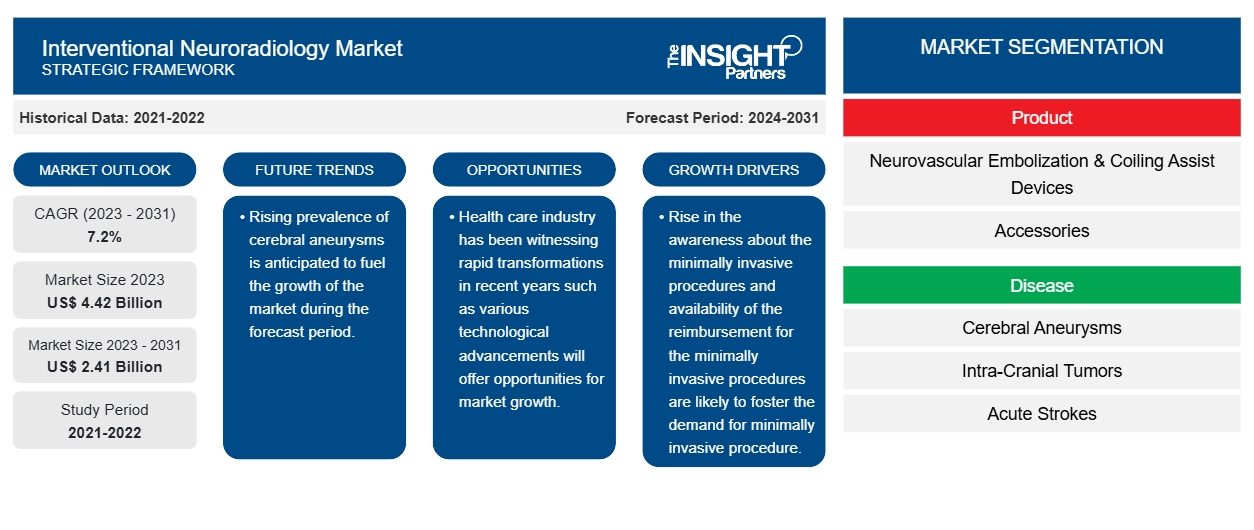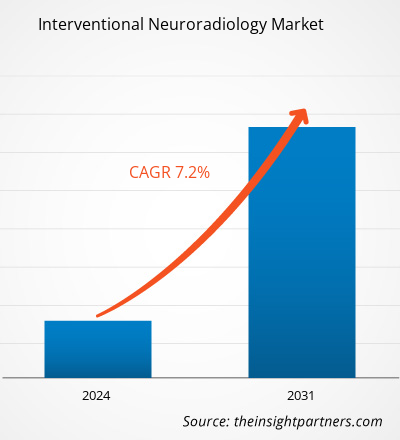The Interventional neuroradiology market size is projected to reach US$ 2.41 billion by 2031 from US$ 4.42 billion in 2023. The market is expected to register a CAGR of 7.2% during 2023–2031. Ongoing clinical trials for the treatment of stroke is thus likely to remain a key trends in the market.
Interventional Neuroradiology Market Analysis
Identifying conditions such as embolisms and ischemia has been made easier and less intrusive by developments and improvements in diagnostic and imaging tools. The Radiological Society of North America reports a 43 percent rise in radiology exams using sophisticated modalities. In 2020, it's anticipated that health data would total more than 2,000 exabytes. Because of this, there is a greater need for neurovascular devices to treat them.
Interventional Neuroradiology Market Overview
A minimally invasive (MIS) medical procedure is generally carried out by inserting a small device in the body through an incision or anatomical opening. Minimally invasive procedures have been performed widely in recent years. Since these incisions are tiny, the patient recovers comparatively faster, with less discomfort. Benefits of a minimally invasive procedure include minor cuts, less trauma to the muscles, tissues, and nerves tissues, less tissue injury, less tissue injury, less pain, less trauma to organs, faster oral intake, and less hospital stay. In addition, the rise in awareness about minimally invasive procedures and the availability of reimbursement for minimally invasive procedures are likely to foster the demand for minimally invasive procedures. Thus, owing to these factors, the market for interventional neuroradiology is likely to propel significantly during the forecast period.
Customize This Report To Suit Your Requirement
You will get customization on any report - free of charge - including parts of this report, or country-level analysis, Excel Data pack, as well as avail great offers and discounts for start-ups & universities
Interventional Neuroradiology Market: Strategic Insights

-
Get Top Key Market Trends of this report.This FREE sample will include data analysis, ranging from market trends to estimates and forecasts.
Interventional Neuroradiology Market Drivers and Opportunities
Rise In The Prevalence Of The Cerebral Aneurysm to Favor Market
Neurological diseases are disorders of the spine, brain, and the nerves that connect them. There are beyond 600 diseases of the nervous system, includes as brain tumors, Parkinson's disease, epilepsy, and stroke, as well as less familiar ones, for instance frontotemporal dementia. In recent years, the prevalence of neurological disorders has increased significantly. A brain aneurysm ruptures every 18 minutes. The annual rupture rate in the United States is around 8 – 10 per 100,000 people. Thus, the rising prevalence of cerebral aneurysms is anticipated to fuel the market's growth during the forecast period.
Development in the Healthcare Market
The health care industry has been witnessing rapid transformations in recent years. Various technological advancements have been witnessed in the industry, such as stem cell therapy, smart brain prosthetics, and transcranial MRI-guided focused ultrasound. Countries across the globe have been preferring advanced technologies in healthcare. With a need for better healthcare capabilities, technology-enabled care (TEC) solutions are preferred in healthcare systems in emerging economies. The increase in the ageing population, incidences of chronic illnesses are the primary factors driving the growth of the healthcare sector. There has been a significant increase in healthcare expenditure in recent years. As per the World Bank, Healthcare expenditure accounts for 9.94% of global GDP. The above factors are expected to offer broad growth opportunities in the healthcare industry at the global level.
Interventional Neuroradiology Market Report Segmentation Analysis
Key segments that contributed to the derivation of the interventional neuroradiology market analysis are product, disease and end user.
- Based on product, the interventional neuroradiology market is divided into neurovascular embolization & coiling assist devices, accessories. The neurovascular embolization & coiling assist devices segment held a larger market share in 2023.
- By disease, the market is bifurcated into cerebral aneurysms, intra-cranial tumors, acute strokes, other diseases. The acute strokes segment held the largest share of the market in 2023.
- By end user, the market is segmented into hospitals, ambulatory surgical centers, other end users. The hospitals segment held the largest share of the market in 2023.
Interventional Neuroradiology Market Share Analysis by Geography
The geographic scope of the interventional neuroradiology market report is mainly divided into five regions: North America, Asia Pacific, Europe, Middle East & Africa, and South & Central America.
The market for interventional neuroradiology in the US holds the largest share among the countries of North America. The market is expected to grow owing to the availability of advanced healthcare infrastructure, the number of neurological disorders, and product innovations introduced by key players operating in the region. In the United States, an increase in the prevalence of neurological disorders has been witnessed in recent years. According to the Brain Aneurysm Foundation’s recent data published in 2023 states, approximately 6.8 million people have unruptured brain aneurysms in the US. Therefore, the prevalence of the brain aneurysm and the developments made by the companies is expected to propel the market's growth during the forecast period.
Interventional Neuroradiology Market Regional Insights
The regional trends and factors influencing the Interventional Neuroradiology Market throughout the forecast period have been thoroughly explained by the analysts at The Insight Partners. This section also discusses Interventional Neuroradiology Market segments and geography across North America, Europe, Asia Pacific, Middle East and Africa, and South and Central America.
Interventional Neuroradiology Market Report Scope
| Report Attribute | Details |
|---|---|
| Market size in 2023 | US$ 4.42 Billion |
| Market Size by 2031 | US$ 2.41 Billion |
| Global CAGR (2023 - 2031) | 7.2% |
| Historical Data | 2021-2022 |
| Forecast period | 2024-2031 |
| Segments Covered |
By Product
|
| Regions and Countries Covered |
North America
|
| Market leaders and key company profiles |
|
Interventional Neuroradiology Market Players Density: Understanding Its Impact on Business Dynamics
The Interventional Neuroradiology Market is growing rapidly, driven by increasing end-user demand due to factors such as evolving consumer preferences, technological advancements, and greater awareness of the product's benefits. As demand rises, businesses are expanding their offerings, innovating to meet consumer needs, and capitalizing on emerging trends, which further fuels market growth.

- Get the Interventional Neuroradiology Market top key players overview
Interventional Neuroradiology Market News and Recent Developments
The Interventional Neuroradiology Market is evaluated by gathering qualitative and quantitative data post primary and secondary research, which includes important corporate publications, association data, and databases. A few of the developments in the interventional neuroradiology market are listed below:
- Royal Philips, a global leader in health technology, announced major enhancements to its Image Guided Therapy System – Azurion – with the launch of its new Azurion neuro biplane system. (Source: Royal Philips, Company Website, February 2024)
- CERENOVUS, Inc., part of Johnson & Johnson MedTech, launched CEREGLIDE 71 Intermediate Catheter, a next-generation intermediate catheter with TruCourse indicated for the revascularization of patients suffering from acute ischemic stroke. (Source: CERENOVUS, Inc., Company Website, February 2024)
Interventional Neuroradiology Market Report Coverage and Deliverables
The “ Interventional Neuroradiology Market Size and Forecast (2021–2031)” report provides a detailed analysis of the market covering below areas:
- Interventional neuroradiology market size and forecast at global, regional, and country levels for all the key market segments covered under the scope
- Interventional neuroradiology market trends as well as market dynamics such as drivers, restraints, and key opportunities
- Detailed PEST/Porter’s Five Forces and SWOT analysis
- Interventional neuroradiology market analysis covering key market trends, global and regional framework, major players, regulations, and recent market developments.
- Industry landscape and competition analysis covering market concentration, heat map analysis, prominent players, and recent developments for the XYZ market
- Detailed company profiles
Frequently Asked Questions
Which region dominated the interventional neuroradiology market in 2023?
What are the driving factors impacting the interventional neuroradiology market?
What are the future trends of the interventional neuroradiology market?
Which are the leading players operating in the interventional neuroradiology market?
What is the expected CAGR of the interventional neuroradiology market?
- Historical Analysis (2 Years), Base Year, Forecast (7 Years) with CAGR
- PEST and SWOT Analysis
- Market Size Value / Volume - Global, Regional, Country
- Industry and Competitive Landscape
- Excel Dataset
Recent Reports
Testimonials
Reason to Buy
- Informed Decision-Making
- Understanding Market Dynamics
- Competitive Analysis
- Identifying Emerging Markets
- Customer Insights
- Market Forecasts
- Risk Mitigation
- Boosting Operational Efficiency
- Strategic Planning
- Investment Justification
- Tracking Industry Innovations
- Aligning with Regulatory Trends





















 Get Free Sample For
Get Free Sample For